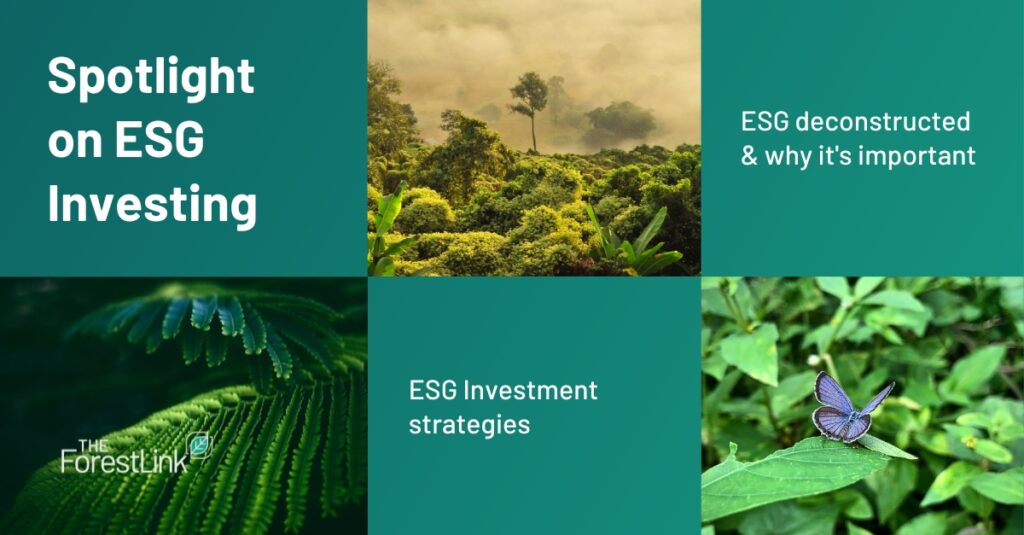In recent years, Environmental, Social, and Governance (ESG) factors have gained significant importance in the world of investment. Investors are increasingly recognizing that financial returns alone are not enough to evaluate the true value and sustainability of a business. This shift in mindset has led to the integration of ESG factors into investment decision-making processes, known as ESG Investing.
In this article, I explore why ESG factors have gained prominence in investment decisions, the fundamental concepts of ESG investing, and explain how they can positively influence both financial returns and have an impact on society, and the planet.

What is ESG Investing?
ESG investing is the act of an investor considering the impact of an investee’s operations on the environment, society, and its governance practices when making investment decisions. ESG investing allows investors to assess financial performance as well as the overall sustainability of investees.
There are several key factors that are driving the push towards greater ESG integration. These include regulatory pressures, consumer demand for sustainable products and services, and investor demand for companies that prioritize ESG practices.
Companies seeking capital that fail to address these factors risk losing out on investment, falling behind their competitors and facing reputational damage and financial losses.
So, what’s involved in ESG factors and why are they important to investment decisions?
Before digging into the Environmental, Social and Governance factors of ESG, it’s important to understand my approach to their consideration. When assessing these factors, investors should be looking to understand where they can reduce ESG risk – or negative impacts on ESG factors and financial performance, where can they increase environmental and social impact, and, where they can add value, or improve an investment’s financial performance through ESG investing.
Environmental Factors:
On the risk reduction side, the environmental aspect of ESG investing emphasizes a company’s efforts to minimize its carbon and nature footprint, reduce pollution, conserve resources, and adopt sustainable practices. On the positive impact side, environmental considerations include adopting regenerative practices that enable environmental conditions to improve after investment. This could include restoring degraded forest or eroded stream banks for example.
One environmental concern on the top of investors’ minds these days is climate change. Specifically, the financial risks associated with it. Companies that fail to address these risks may face regulatory penalties, reputational damage, and increased operational costs. As such, investors are increasingly seeking out companies and industries to invest in with environmentally responsible practices, such as those focused on sustainable forestry, renewable energy, energy efficiency, waste reduction, and responsible resource management. When considering sustainable forestry – investments along the entire value chain can meet climate objectives – planting, through harvesting, processing, and end use (such as in the construction industry as a substitution for emission-heavy alternatives like concrete and steel). Investments into sustainable and renewable forest value chains can also have positive impacts on biodiversity, soil and water integrity and cultural values.
Many global brands have made big commitments to reduce their environmental impact. For example, Microsoft, in 2020 committed to becoming carbon negative, water positive and zero waste by 2030. The company’s 2022 Environmental Sustainability Report pledges to protect more land than they use by 2025, in recognition of the impact that the company’s operations have on ecosystems around the world. Microsoft is committed to “supporting localized nature-based solution projects with a flexible, multi-functional, and adaptable approach to simultaneously improve human well-being, social equity, and environmental health for vulnerable communities.” In 2021 Microsoft contributed to the TNC Belize Maya Forest Project (BMF) to protect an additional 236,000 acres of the Selva Maya – the “Jewel” of Central America and a global biodiversity hotspot. In December 2021, these acres were placed under declaration of trust by the Belizean government. You can read more about Microsoft’s ESG commitments here.
By investing in environmentally conscious companies, investors can support sustainable business practices while potentially benefiting from their long-term growth potential.
Social Factors:
The social dimension of ESG investing focuses on a company’s impact on society and its stakeholders. It considers how a company treats its employees, its workforce diversity, how it engages with the local community, and manages its supply chain.
Socially responsible investing aims to support companies that prioritize fair labor practices, diversity and inclusion, human rights, and community development. By investing in socially responsible companies, investors can contribute to positive societal change, reduce reputational risks associated with unethical behavior, and support businesses that align with their values.
Studies have shown that companies with strong social performance often exhibit better operational efficiency, employee engagement, and customer loyalty, which can ultimately translate into improved financial performance.
Dutch chocolate brand, Tony Chocolonely’s mission is to make the chocolate industry 100% slave free. They are tackling illegal child labour and modern slavery on cocoa farms by investing in long term partnerships with farmer cooperatives, paying farmers a higher price, and investing in agricultural education and knowledge to help them improve productivity and therefore, their income. Whilst they still have work to do in this field, they are one of the companies leading the way in ethical practices within the chocolate industry.
To tackle racial and social equity, Starbucks announced a mentorship program to connect black, indigenous, and people of color (BIPOC) to senior leaders and invest in partnerships. The chain also aims to have BIPOC represented at 30% in corporate roles and 40% in retail and manufacturing by 2025.
Governance Factors:
The governance aspect of ESG investing focuses on the structure, transparency, and accountability of a company’s management and board of directors.
Good governance practices ensure that decision-making is ethical, responsible, and aligned with the long-term interests of shareholders. Companies with strong governance frameworks tend to have independent boards, effective risk management systems, transparent reporting, and responsible executive compensation practices.
A top governance consideration in the investment community is boardroom diversity. Executive-level diversity has become a focus for many policymakers and investors who say a broader range of experience and perspectives facilitated by top-level diversity improves decision-making and corporate culture. An example of how this is integrated into policy is that through the EU’s Sustainable Finance Disclosure Regulation (SFDR), financial institutions are required to report on unadjusted gender pay gap, and board gender diversity.
In February 2023, Reuters reported that women’s share of board seats at Britain’s 350 biggest listed companies reached 40% for the first time in 2022, three years ahead of the 2025 target.
ESG Investing Strategies:
How do investors analyse ESG factors?
1. Screening and Thematic Investing:
One strategy employed by ESG-conscious investors is screening, which involves excluding certain industries or companies from their investment portfolio based on specific ESG criteria. For example, investors may choose to avoid investing into companies involved in tobacco, firearms, or fossil fuels.
Thematic investing focuses on investing in companies that contribute to a specific sustainability theme, such as reforestation, renewable energy, clean technology, or water conservation. By targeting companies aligned with their values, investors can actively support sustainable sectors and make a positive impact.
2. Integration of ESG Factors:
This approach involves considering a company’s ESG performance alongside traditional financial metrics when evaluating investment opportunities. By incorporating ESG considerations into the decision-making process, investors can gain a more comprehensive understanding of a company’s long-term prospects and risks.
To effectively integrate ESG factors into investment decisions, investors rely on ESG data and ratings. ESG data providers collect and analyze information on companies’ ESG practices and performance. They consider a wide range of factors, including carbon emissions, diversity metrics, supply chain management, and board composition.
ESG ratings assess a company’s ESG performance and provide investors with a standardized measure to compare and evaluate companies. In sectors or instances where formal ESG data and ratings do not yet exist – ESG-minded companies often take matters into their own hands and carry out their own, transparent ESG management and reporting. This is still the common approach in forest investments, where ESG factors are complex and nuanced – where the granularity of formal ESG ratings is insufficient to address ESG in forestry.
3. Engagement
Engagement refers to the active involvement of investors in communication with companies regarding their ESG practices. ESG-conscious investors can use their influence as shareholders to encourage companies to adopt sustainable or regenerative practices, improve disclosures, and address ESG concerns.
4. Impact Investing
Impact investing goes beyond solely considering financial returns and aims to additionally generate measurable positive social or environmental impacts. This strategy involves investing in companies, organizations, or projects that specifically target and address societal or environmental challenges. Impact investors actively seek out opportunities to make a difference while earning competitive financial returns.
What does this mean for companies seeking investment?
If businesses require investment, it is imperative that they integrate ESG practices into their business models. This is not to say that it is a simple task.
Reuters Events identify the challenges facing companies in their white paper ‘ESG Under Strain’. These include a lack of clear ESG guidelines and standards, difficulties in measuring and reporting ESG performance, and the need to balance short-term financial performance with long-term ESG goals. Side note – this doesn’t need to be a trade-off.
To overcome these challenges, companies must take a more holistic approach to ESG, integrating it into all aspects of their operations and decision-making processes. This requires a commitment from top-level management to prioritize ESG, as well as investment in data collection and analysis tools to measure ESG performance and identify areas for improvement.
At the start of a company’s ESG journey, it is important to realize that it likely is already managing ESG factors, perhaps without realising it. In a previous article, I suggested a brainstorming session with the management team to identify all the risks and which risks are cross-cutting with ESG. I would expand this to also include impact opportunities, where positive environmental, social and governance benefits can be achieved. You can read more about this here.
Financial Benefits of ESG Investing
Contrary to the misconception that ESG investing requires sacrificing financial returns, numerous studies have indicated a positive correlation between ESG factors and long-term financial performance.
Companies that proactively manage ESG risks tend to be better prepared for regulatory changes, market shifts, and emerging sustainability trends. They are often more innovative, resilient, and positioned for growth in a rapidly changing world.
Additionally, increasing investor demand for ESG investments has created a virtuous cycle, driving capital towards companies with strong ESG performance, which in turn can boost their stock prices.
ESG factors have emerged as critical considerations for investors, enabling them to assess the true value, sustainability, and risk profile of their investments. By integrating ESG factors into investment decisions, investors can foster long-term value creation, mitigate risks, make a positive impact, enhance reputation, and navigate the changing regulatory landscape.
Learn more about my ESG Integration Approach
If you are interested in strengthening the ESG credentials of your traditional forest or other land-based investments, my ESG integration approach might be right for you. I offer the following services:
- ESG Integration Strategy Roadmap – If you are in the early stages of designing a new investment strategy, with this roadmap you will get an actionable plan to integrate risk-reducing, benefit-creating and value-generating ESG into your strategy.
- ESG Integration Workshops – If you are making the transition from a conventional forest or land-based investment strategy to one that integrates ESG objectives, or you are new to forest and land-based investments, these workshops will help your team get up to speed on the opportunities, and address concerns with ESG integration, and get your whole team co-creating an ESG-integrated investment strategy you will all stand behind.
- Customized ESG Management Framework Development – If you are ready to build the bridge between ESG integrated strategy and implementation, but lack the resources to build the systems yourself, I can support to build your ESG Framework customized to your strategy.
- ESG Integration Advisory – If you have the horsepower to build up your integrated ESG strategy and management framework in house, but would like advisory support to discuss ideas, solutions, and opportunities – this customized service will help you efficiently and confidently move your strategy into action.
This approach is also applied to forest and land-based companies, looking for a straightforward approach to meet investors’ ESG requirements.
Please reach out if you are an investor, investment manager or forest/land-based company interested to see how my integrated ESG approach could best serve your needs.
Did you like this article? Sign up now for the ForestLink’s newsletter, where you’ll receive technical advice, reflections, and best-practice guidance to support you with your forest-linked investment strategy or business straight to your inbox.





